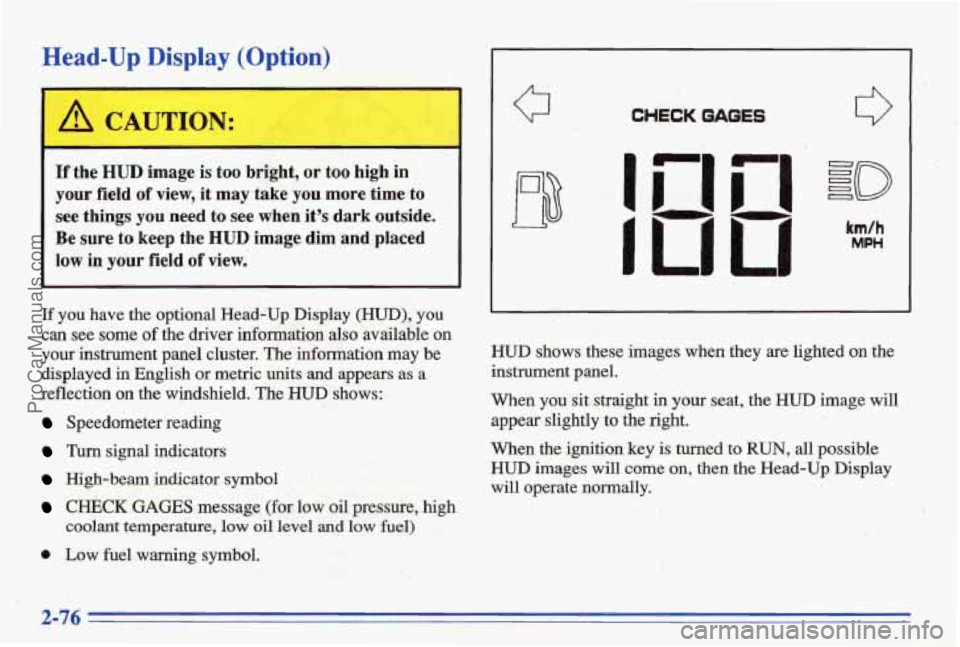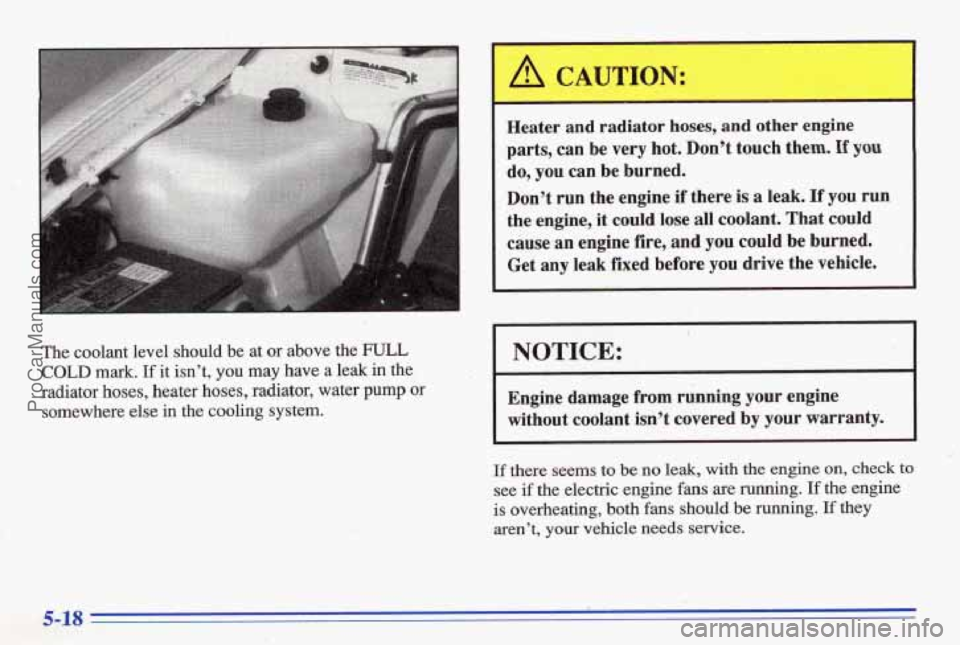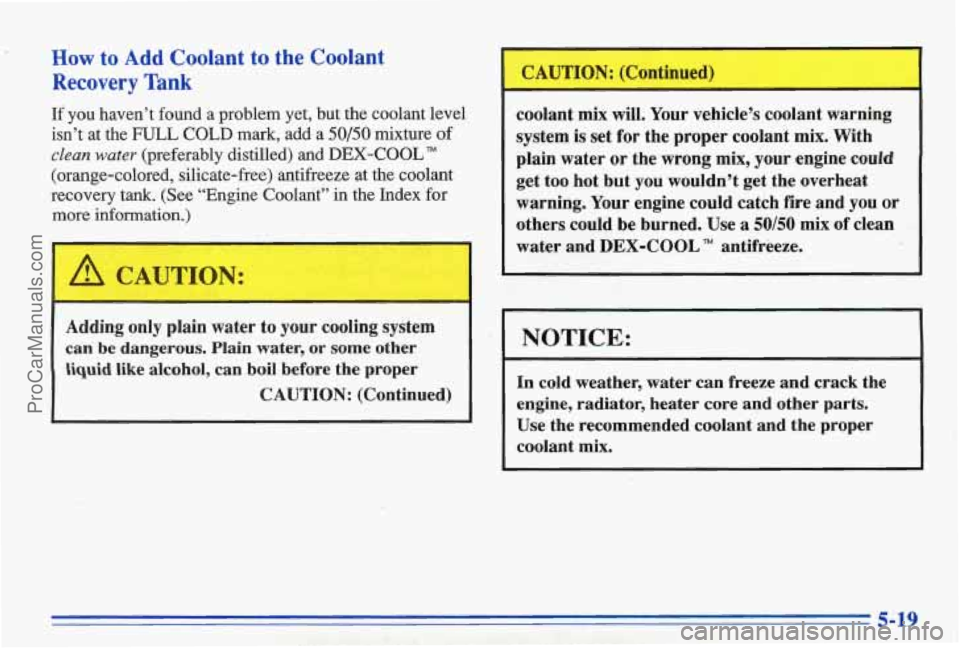1996 PONTIAC BONNEVILLE coolant level
[x] Cancel search: coolant levelPage 119 of 387

Low Coolant Warning Light
LOW
COOLANT
If you have this light and it
comes on, your system may
be low on coolant and the
engine may overheat.
Check to see
if the level is low at the recovery tank, and
add coolant if necessary. If the level is not low, have
your low
coolant warning system serviced. See “Engine
Coolant”
in the Index.
The
LOW COOLANT warning light will also come on
when you
turn on the ignition, but your engine is not
running, as a check to show you it is working. If it
doesn’t come on then, have
it fixed right away.
After the buIb check, the light will go out for 20 seconds.
If the light comes back on after 20 seconds, the system
may
be low on ,coolant. See “Engine Coolant’’ in
the Index.
Engine Coolant Temperature Gage
This gage shows the engine
coolant temperature.
If the gage pointer moves
into the red
,area, your
engine
is too hot! The
CHECK GAGES light
will
go on and a warning
chime
will sound, if you
have this option.
It means that your engine coolant has overheated.
If you
have been ‘operating your vehicle under
normal driving
conditions,
you should pull off the road, stop your
vehicle
and turn ,off the engine as soon as possible.
In the section “Problems on the Road,” this manual
explains what to do. See “Engine Overheating”
in
the Index.
, .-; ’.
. . -.
ProCarManuals.com
Page 127 of 387

Head-Up. Display (Opth)
If the HUD image is too bright, or too high in
.your field
of view, it may take you more time to
see things
you need to see when it's dark outside.
Be sure to keep
the HUD image dim and placed
low
in your field of view.
If you have the optional Head-Up Display (HUD), you
can see some
of the driver information also mailable on
your instrument panel cluster. The infomation may be
displayed in English or metric units and appears
as a
reflection on the wjndshield. The
HUD shows:
Speedometer reading
Turn signal indicators
High-beam indicator symbol
CHECK GAGES message (for law oil pressure, high
coolant temperature,
low oil level and low fuel)
0 Low fuel warning symbol.
Q CHECK GAGES
I
I
km/h
MPH
HWD shows these images when they are lighted on the
instrument
panel.
When you sit straight in your seat, the HUD image will
appear slightly to the right.
When
the ignition key is turned to RUN, all possible
HUD images will come on, then the Head-Up Display
will operate
normally,,
2-76
ProCarManuals.com
Page 130 of 387

Driver Information Center
3 (-1 INFORMATION (I , J,
DRIVER TRIP
CHECK OIL LEVEL
WASHER FLUID
LOW COOLANT
CHECK QAOES
VOOD DOOR
TRUNK AJAR I
I
MlLES
888888
LAMP
MONITOR
TURN SIQNAL
BACK UP TAIL
BRAKE LAMP
TRIP
8 B 8 8.8
If you have the Driver Information Center, it gives you
important safety and maintenanc,e facts. When you turn
the ignition on, the entire center lights
up for a few
seconds. Then it goes to work.
. ..
..
.. -*
FUNCTION MONITOR: This lets you know if
you are low on fluids or have a problem with a
vehicle function:
CHECK OIL LEVEL: This message could mean
your oil level is low.
If it comes on for more than
three seconds, see "Check Oil Level
Warning Light" . ..
in the Index. - I
WASHER FLUID: This message means your
washer fluid tank is less than about
30% full. 'The
windshield portion of the vehicle outline
will also
glow.
If these come on, see "Windshield Washer
Fluid"
in the Index.
LOW COOLANT This message means your
coolant level has fallen to about half
full. If it comes
on, see "Engine Coolant" in the Index.
CHECK GAGES: If this light comes on and stays
on while you are driving, check your gages for fuel,
coolant temperature, oil pressure or battery voltage.
~. h I_ - I e:. ..
SECURITY: You'll get a DOOR AJAR message if a
door is not fully closed. The vehicle outline will show
you which door it is. You
will also get a HOOD AJAR
or TRUNK AJAR message if the hood or the trunk isn't
fully closed. The vehicle outline will
also show you
these are
ajar. ;,. . . ,--. . ,(/,,:-I.. - : , , .. , .. . . . .! _.
ProCarManuals.com
Page 141 of 387

Pressing the AUTO button will display the requested
temperature, fan speed'and
air delivery mode for five
seconds, then change to display the outside air
temperature. Be careful not to put anything over the
sensor located in the middle
of the instrument panel near
the windshield, or over the sensor
in the gnlle above the
radio. These sensors are used by the automatic system to
regulate temperature.
The exterior temperature display sensor is in front
of the
car, near the radiator. This displayed temperature is most
accurate when the vehicle
is moving. During stops, or
while idling, the display shows the previous driving
temperature for best system control.
To avoid blowing cold air in cold weather, the system
will delay turning
on the fan until warm air is available.
The length
of delay depends on outside air temperature,
engine coolant temperature, and time since the engine
was last started. Pushing the
fan button will override this
delay and change the fan to a selected single speed.
If you leave your vehicle, the system will remember the
control setting the next time you start your engine.
Manual Operation
You may also manually adjust the delivery mode or
fan speed.
'!! HEAT: Manually selecting HEAT by cycling
through the
MODE settings will deliver air to the floor
outlets.
+# DEFOG: Manually selecting DEFOG by cycling
through the
MODE settings will deliver air to the floor
and windshield outlets.
12 BI-LEVEL: Manually selecting BI-LEVEL by
cycling through the MODE setting will deliver warm air
to the floor and cooler air to the middle instrument panel outlets.
OFF: Press this button to turn the system off. Fresh air
will continue to flow through the vehicle, and the
system
will try to maintain the previously set
temperature. The outside temperature will show in the
display when the system
is OFF.
w.
ProCarManuals.com
Page 223 of 387

,
‘The coolant level should be at or above the FULL
% COLD mark. If it isn’t, you may have a leak in the
. radiator hoses, heater hoses, radiator, water pump or
somewhere else in the cooling system.
A CAWTION:
Heater and radiator hoses, and other engine
parts, can be
very hot. Don’t touch them. If you
do, you can be burned.
Don’t mn the engine
if there is a leak. If you run
’ the engine, it could lose all coolant. That could
cause an engine
fire, and you could be burned.
Get any leak fixed before you drive the vehicle.
I NOTICE:
I
Engine damage from running your engine
without coolant isn’t covered by your warranty.
I
If there seems to be no leak, with the engine on, check to
see if the electric engine fans are running. If the engine
is overheating, both fans should be running. If they
aren’t, your vehicle needs service.
ProCarManuals.com
Page 224 of 387

How to Add Coolant to the Coolant
Recovery Tank
If you haven’t found a problem yet, but the coolant level
isn’t at the
FULL COLD mark, add-a 50/50 mixture of
clean water (preferably distilled) and DEX-COOL TM
(orange-colored, silicate-free) antifreeze at the coolant
recovery tank. (See “Engine Coolarit” in the Index for
more information.)
Adding only plain water to your cooning system
can be dangerous. Plain water, or some other
liquid like alcohol, can boil before the proper
CAUTION: (Continued) -coolant
mix will. Your vehicle’s coolant warning
system
is set for the proper coolant mix. With
plain water or the wrong mix, your engine could
get too hot but you wouldn’t get the overheat
warning. Your engine could catch fire and you or
others could be burned. Use a
50/50 mix of clean
water and
DEX-COOL TM antifreeze.
NOTICE:
In cold weather, water can freeze and crack the
engine, radiator, heater core
and other parts.
Use the recommended coolant and the proper
coolant mix.
ProCarManuals.com
Page 228 of 387

4. Then fill the coolant recovery tank to the FULL
COLD mark.
5. Put the cap back on the coolant recovery tank, but
leave the radiator pressure cap
off.
6. Start the engine and let it mn until you can feel the
upper radiator hose getting hot. Watch out for the
engine fans.
filler neck
may be lower. If the level is lower, add '
more of the proper mix through the filler neck until
the level reaches the base of the filler neck.
7. By this time the coolant level inside the radiator
ProCarManuals.com
Page 267 of 387

How to Add Fluid
Refer to the Maintenance Schedule to determine what
bind of tmhsaxle fluid to use. See 6‘Recomended
Fluids and Lubricants” in the Index.
If the fluid level is low, add only enough of the proper
fluid to bring
the level into the cross-hatched area on
the dipstick.
Pull out the dipstick.
Using a long-neck funnel, add enough
Md at the
dipstick hole to bring it to the proper level. It doesn’t
take much
fluid, generally less than a pint (0.5 L).
Don’t overfiI2. We recommend you use only fluid
labeled
DEXRON*-III,, because fluid with that label
is made especially for yo& automatic transax18e.
Damage caused
by fluid other than DEXRON’@-III
is not covered by your new vehicle warranty.
After adding fluid, recheck the fluid level as
described under “How to Check.”
When the correct fluid level is obtained, push the
dipstick back in
all the way.
Engine Coolant
The cooling system in your vehicle is filled with new
DEX-COOL (orange-colored,
silicate-free) engine
coolant.
This coolant is designed to remain in your
vehicle for 5 years or 100,000 miles (166 000 km),
whichever occurs first.
The following explains your cooling system and how to
add coolant when it is low.
If you have a problem with
engine overheating, see “Engine Overheating” in
the Index.
A 50/50 mixture of water &d the proper coolant for
your Pontiac will:
e
e
0
0
0
Give freezing protection down to -34°F (-37°C).
Give boiling protection up to 265 OF (1 29 O C).
Protect against rust and corrosion.
Help keep the proper engine temperature.
Let the warning lights and gages work as they should.
ProCarManuals.com